| Leader | Term of office | Other ministerial offices held as Leader of the House of Lords | Political party | Prime Minister |
|---|
|  | Charles Spencer
3rd Earl of Sunderland [2] | April
1717 | March
1718 | – Secretary of State for the Northern Department | | No such office |
|  | James Stanhope
1st Earl Stanhope [2]
Viscount Stanhope until April 1718 | March
1718 | 5 February
1721 | – Secretary of State for the Northern Department | | No such office |
|  | Charles Townshend
2nd Viscount Townshend [2] | February
1721 | May
1730 | – Secretary of State for the Northern Department | Whig | | Robert Walpole |
|  | William Stanhope
1st Earl of Harrington [2]
Lord Harrington until 1742 | May
1730 | February
1742 | – Secretary of State for the Northern Department | |
|  | John Carteret
2nd Earl Granville
Baron Carteret until 1744 | 12 February
1742 | 24 November
1744 | – Secretary of State for the Northern Department | Whig | | Spencer Compton, 1st Earl of Wilmington (until July 1743) |
| Henry Pelham (from 27 August 1743) |
|  | William Stanhope
1st Earl of Harrington [2] | November
1744 | October
1746 | – Secretary of State for the Northern Department | |
|  | Philip Dormer Stanhope
4th Earl of Chesterfield [2] | October
1746 | February
1748 | – Secretary of State for the Northern Department | Whig |
|  | Thomas Pelham-Holles
1st Duke of Newcastle | February
1748 | 16 November
1756 | – Secretary of State for the Northern Department until March 1754– Prime Minister from March 1754 | Whig |
| Himself |
|  | William Cavendish
4th Duke of Devonshire | 16 November
1756 | 25 June
1757 | – Prime Minister | Whig | | Himself |
|  | Thomas Pelham-Holles
1st Duke of Newcastle | 2 July
1757 | 26 May
1762 | – Prime Minister | Whig | | Himself |
|  | Charles Wyndham
2nd Earl of Egremont [2] | May
1762 | 21 August
1763 | – Secretary of State for the Southern Department | | | John Stuart, 3rd Earl of Bute (until April 1763) |
| George Grenville (from 16 April 1763) |
|  | George Montagu Dunk
2nd Earl of Halifax [2] | August
1763 | July
1765 | – Secretary of State for the Southern Department | |
|  | Charles Watson-Wentworth
2nd Marquess of Rockingham | 13 July
1765 | 30 July
1766 | – Prime Minister | Whig
(Rockingham) | | Himself |
|  | Augustus FitzRoy
3rd Duke of Grafton | 1766 | 28 January
1770 | – First Lord of the Treasury – Prime Minister from October 1768 | Whig
(Chathamite) | | William Pitt, 1st Earl of Chatham (William Pitt the Elder)
(until October 1768) |
| Himself (from 14 October 1768) |
|  | Thomas Thynne
3rd Viscount Weymouth [2] | January
1770 | December
1770 | – Secretary of State for the Southern Department | | | Lord North |
|  | William Nassau de Zuylestein
4th Earl of Rochford [2] | December
1770 | November
1775 | – Secretary of State for the Southern Department | |
|  | Henry Howard
12th Earl of Suffolk [2] | November
1775 | 6 March
1779 | – Secretary of State for the Northern Department | |
|  | Thomas Thynne
3rd Viscount Weymouth [2] | March
1779 | November
1779 | – Secretary of State until October 1779
- Secretary of State for the Southern Department from October 1779 | |
|  | David Murray
7th Viscount Stormont [2] | November
1779 | March
1782 | – Secretary of State for the Northern Department | |
|  | William Petty
2nd Earl of Shelburne | March
1782 | April
1783 | – Secretary of State for the Home Department until July 1782
– Prime Minister from July 1782 | Whig
(Rockingham) | | Charles Watson-Wentworth, 2nd Marquess of Rockingham (until 1 July 1782) |
| Himself (from 4 July 1782) |
|  | William Cavendish-Bentinck
3rd Duke of Portland | 2 April
1783 | December
1783 | – Prime Minister | Whig
(Foxite) | | Himself
(figurehead) |
|  | George Nugent-Temple-Grenville
3rd Earl Temple [3] | December
1783 | December
1783 | – Home Secretary – Foreign Secretary | – | | William Pitt the Younger |
|  | Thomas Townshend
1st Baron Sydney [3] | December
1783 | June
1789 | – Home Secretary | Whig |
|  | Francis Osborne
5th Duke of Leeds [3] | 1789 | 1790 | – Secretary of State for Foreign Affairs | Tory |
|  | William Grenville
1st Baron Grenville [3] | November
1790 | February
1801 | – Secretary of State for the Home Department until June 1791
– Secretary of State for Foreign Affairs from June 1791 | Tory |
| 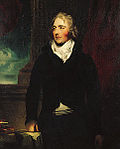 | Robert Hobart
Baron Hobart [4] | March
1801 | October
1801 | – Secretary of State for War and the Colonies | Tory | | Henry Addington |
|  | Thomas Pelham
Baron Pelham [3] | October
1801 | August
1803 | – Secretary of State for the Home Department | Tory |
|  | Robert Jenkinson
Baron Hawkesbury [3] | November
1803 | February
1806 | – Secretary of State for Foreign Affairs until May 1804
– Secretary of State for the Home Department from May 1804 | Tory |
| William Pitt the Younger |
|  | William Grenville
1st Baron Grenville [3] | 11 February
1806 | March
1807 | – Prime Minister | Whig | | Himself
(Ministry of All the Talents) |
|  | Robert Jenkinson
2nd Earl of Liverpool [3]
Baron Hawkesburyuntil 1808
Earl of Liverpool from 1808 | 25 March
1807 | April
1827 | – Secretary of State for the Home Department until November 1809
– Secretary of State for War and the Colonies November 1809 – June 1812
– Prime Minister from June 1812 | Tory | | 3rd Duke of Portland |
| Spencer Perceval |
| Himself |
|  | F. J. Robinson
1st Viscount Goderich [3] | 30 April
1827 | January
1828 | Secretary of State for War and the Colonies until September 1827
– Prime Minister from August 1827 | Tory | | George Canning |
| Himself |
|  | Arthur Wellesley
1st Duke of Wellington [3] | January
1828 | November
1830 | – Prime Minister | Tory | | Himself |
| 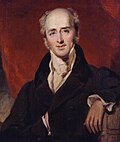 | Charles Grey
2nd Earl Grey | 22 November
1830 | 9 July
1834 | – Prime Minister | Whig | | Himself |
|  | William Lamb
2nd Viscount Melbourne | 16 July
1834 | 14 November
1834 | – Prime Minister | Whig | | Himself |
|  | Arthur Wellesley
1st Duke of Wellington | 17 November
1834 | 8 April
1835 | – Prime Minister until December 1834
– Secretary of State for the Home Department until December 1834
– Secretary of State for War and the Colonies until December 1834
– Secretary of State for Foreign Affairs | Tory | | Himself
(Caretaker) |
| Robert Peel |
|  | William Lamb
2nd Viscount Melbourne | 18 April
1835 | 30 August
1841 | – Prime Minister | Whig | | Himself |
|  | Arthur Wellesley
1st Duke of Wellington | 3 September
1841 | 27 June
1846 | – Minister without portfolio | Conservative | | Robert Peel |
|  | Henry Petty-Fitzmaurice
3rd Marquess of Lansdowne | 6 July
1846 | 21 February
1852 | – Lord President of the Council | Whig | | Lord John Russell |
|  | Edward Smith-Stanley
14th Earl of Derby | 23 February
1852 | 17 December
1852 | – Prime Minister | Conservative | | Himself |
|  | George Hamilton-Gordon
4th Earl of Aberdeen | 19 December
1852 | 30 January
1855 | – Prime Minister | Peelite | | Himself
(Coalition) |
|  | Granville Leveson-Gower
2nd Earl Granville | 8 February
1855 | 21 February
1858 | – Lord President of the Council | Whig | | Henry John Temple, 3rd Viscount Palmerston |
|  | Edward Smith-Stanley
14th Earl of Derby | 21 February
1858 | 11 June
1859 | – Prime Minister | Conservative | | Himself |
|  | Granville Leveson-Gower
2nd Earl Granville | 18 June
1859 | 29 October
1865 | – Lord President of the Council | Liberal | | Viscount Palmerston |
|  | John Russell
1st Earl Russell | 29 October
1865 | 26 June
1866 | – Prime Minister | Liberal | | Himself |
|  | Edward Smith-Stanley
14th Earl of Derby | 28 June
1866 | 25 February
1868 | – Prime Minister | Conservative | | Himself |
|  | James Harris
3rd Earl of Malmesbury | 27 February
1868 | 1 December
1868 | – Lord Keeper of the Privy Seal | Conservative | | Benjamin Disraeli |
|  | Granville Leveson-Gower
2nd Earl Granville | 9 December
1868 | 17 February
1874 | – Secretary of State for the Colonies until July 1870
– Secretary of State for Foreign Affairs from July 1870 | Liberal | | William Ewart Gladstone |
|  | Charles Gordon-Lennox
6th Duke of Richmond | 21 February
1874 | 21 August
1876 | – Lord President of the Council | Conservative | | Benjamin Disraeli |
|  | Benjamin Disraeli
1st Earl of Beaconsfield | 21 August
1876 | 21 April
1880 | – Prime Minister – Lord Keeper of the Privy Seal from August 1876 until February 1878 | Conservative |
|  | Granville Leveson-Gower
2nd Earl Granville | 28 April
1880 | 9 June
1885 | – Secretary of State for Foreign Affairs | Liberal | | William Ewart Gladstone |
|  | Robert Gascoyne-Cecil
3rd Marquess of Salisbury | 23 June
1885 | 28 January
1886 | – Prime Minister
– Secretary of State for Foreign Affairs | Conservative | | Himself |
|  | Granville Leveson-Gower
2nd Earl Granville | 6 February
1886 | 20 July
1886 | – Secretary of State for the Colonies | Liberal | | William Ewart Gladstone |
|  | Robert Gascoyne-Cecil
2nd Marquess of Salisbury | 25 July
1886 | 11 August
1892 | – Prime Minister
– Secretary of State for Foreign Affairs from January 1887 | Conservative | | Himself |
|  | John Wodehouse
1st Earl of Kimberley | 18 August
1892 | 5 March
1894 | – Lord President of the Council | Liberal | | William Ewart Gladstone |
| 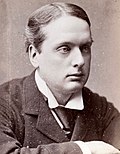 | Archibald Primrose
5th Earl of Rosebery | 5 March
1894 | 21 June
1895 | – Prime Minister | Liberal | | Himself |
|  | Robert Gascoyne-Cecil
3rd Marquess of Salisbury | 25 June
1895 | 11 July
1902 | – Prime Minister
– Secretary of State for Foreign Affairs until November 1900
– Lord Keeper of the Privy Seal from 12 November 1900 | Conservative | | Himself |
|  | Spencer Cavendish
8th Duke of Devonshire | 12 July
1902 | 13 October
1903 | – Lord President of the Council | Liberal Unionist | | Arthur Balfour
(Conservative) |
|  | Henry Petty-Fitzmaurice
5th Marquess of Lansdowne | 13 October
1903 | 4 December
1905 | – Secretary of State for Foreign Affairs | Liberal Unionist |
|  | George Robinson
1st Marquess of Ripon | 10 December
1905 | 14 April
1908 | – Lord Keeper of the Privy Seal | Liberal | | Henry Campbell-Bannerman |
|  | Robert Crewe-Milnes
1st Marquess of Crewe
Earl of Creweuntil 1911
Marquess of Crewe from 1911 | 14 April
1908 | 10 December
1916 | – Secretary of State for the Colonies May 1908– November 1910
– Lord Keeper of the Privy Seal October 1908 – October 1911; February 1912 – May 1915
– Secretary of State for India November 1910 – March 1911; May 1911 – May 1915
– Lord President of the Council from May 1915
– President of the Board of Education from August 1916 | Liberal | | H. H. Asquith |
|  | George Curzon
1st Marquess Curzon of Kedleston
Earl Curzon of Kedlestonuntil 1921
Marquess Curzon of Kedleston from 1921 | 10 December
1916 | 22 January
1924 | – Lord President of the Council until October 1919
– Secretary of State for Foreign Affairs from October 1919 | Conservative | | David Lloyd George
(Liberal) |
| Bonar Law |
| Stanley Baldwin |
|  | Richard Haldane
1st Viscount Haldane | 22 January
1924 | 3 November
1924 | – Lord High Chancellor of Great Britain | Labour | | Ramsay MacDonald |
|  | George Curzon
1st Marquess Curzon of Kedleston | 3 November
1924 | 20 March
1925 | – Lord President of the Council | Conservative | | Stanley Baldwin |
|  | James Gascoyne-Cecil
4th Marquess of Salisbury | 27 April
1925 | 4 June
1929 | – Lord Keeper of the Privy Seal | Conservative |
|  | Charles Cripps
1st Baron Parmoor | 7 June
1929 | 24 August
1931 | – Lord President of the Council | Labour | | Ramsay MacDonald |
|  | Rufus Isaacs
1st Marquess of Reading | 24 August
1931 | 5 November
1931 | – Secretary of State for Foreign Affairs | Liberal | | Ramsay MacDonald |
|  | Douglas Hogg
1st Viscount Hailsham | 5 November
1931 | 7 June
1935 | – Secretary of State for War | Conservative |
|  | Charles Vane-Tempest-Stewart
7th Marquess of Londonderry | 7 June
1935 | 22 November
1935 | – Lord Keeper of the Privy Seal | Conservative | | Stanley Baldwin |
|  | Edward Wood
1st Viscount Halifax | 22 November
1935 | 21 February
1938 | – Lord Keeper of the Privy Seal until May 1937
– Lord President of the Council from 28 May 1937 | Conservative |
| Neville Chamberlain |
| 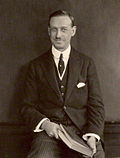 | James Stanhope
7th Earl Stanhope | 21 February
1938 | 14 May
1940 | – President of the Board of Education until October 1938
– First Lord of the Admiralty October 1938 to September 1939
– Lord President of the Council September 1939 to May 1940 | Conservative |
|  | Thomas Inskip
1st Viscount Caldecote | 14 May
1940 | 3 October
1940 | – Secretary of State for Dominion Affairs | Conservative | | Winston Churchill |
|  | Edward Wood
1st Viscount Halifax | 3 October
1940 | 22 December
1940 | – Secretary of State for Foreign Affairs | Conservative |
|  | George Lloyd
1st Baron Lloyd | 22 December
1940 | 4 February
1941 | – Secretary of State for the Colonies | Conservative |
|  | Walter Guinness
1st Baron Moyne | 8 February
1941 | 21 February
1942 | – Secretary of State for the Colonies | Conservative |
|  | Robert Gascoyne-Cecil
Viscount Cranborne | 21 February
1942 | 26 July
1945 | – Secretary of State for the Colonies to November 1942
– Lord Keeper of the Privy Seal November 1942 to September 1943
– Secretary of State for Dominion Affairs September 1943 to 1945 | Conservative |
|  | Christopher Addison
1st Viscount Addison | 3 August
1945 | 26 October
1951 | – Secretary of State for Dominion Affairs until July 1947
– Secretary of State for Commonwealth Relations July 1947 – October 1947
– Lord Keeper of the Privy Seal October 1947 – March 1951
– Paymaster General July 1948– April 1949
– Lord President of the Council from March 1951 | Labour | | Clement Attlee |
|  | Robert Gascoyne-Cecil
5th Marquess of Salisbury | 28 October
1951 | 29 March
1957 | – Lord Keeper of the Privy Seal until May 1952
– Secretary of State for Commonwealth Relations March 1952– November 1952
– Lord President of the Council from November 1952 | Conservative | | Winston Churchill |
| Anthony Eden |
|  | Alec Douglas-Home
14th Earl of Home | 29 March
1957 | 27 July
1960 | – Secretary of State for Commonwealth Relations
– Lord President of the Council until September 1957; from October 1959 | Conservative | | Harold Macmillan |
|  | Quintin Hogg
2nd Viscount Hailsham | 27 July
1960 | 20 October
1963 | – Lord President of the Council
– Minister for Science | Conservative |
|  | Peter Carington
6th Baron Carrington [5] | 20 October
1963 | 16 October
1964 | – Minister without portfolio | Conservative | | Alec Douglas-Home |
|  | Frank Pakenham
7th Earl of Longford [5] | 18 October
1964 | 16 January
1968 | – Lord Keeper of the Privy Seal until December 1965; from April 1966
– Secretary of State for the Colonies December 1965 – April 1966 | Labour | | Harold Wilson |
| | Edward Shackleton
Baron Shackleton [5] | 16 January
1968 | 19 June
1970 | – Lord Keeper of the Privy Seal until April 1968; from October 1968
– Paymaster General April 1968 – November 1968 | Labour |
|  | George Jellicoe
2nd Earl Jellicoe [5] | 20 June
1970 | 23 May
1973 | – Lord Keeper of the Privy Seal | Conservative | | Edward Heath |
| | David Hennessy
3rd Baron Windlesham [5] | 5 June
1973 | 4 March
1974 | – Lord Keeper of the Privy Seal | Conservative |
| | Malcolm Shepherd
2nd Baron Shepherd [5] | 7 March
1974 | 10 September
1976 | – Lord Keeper of the Privy Seal | Labour | | Harold Wilson |
| James Callaghan |
| | Fred Peart
Baron Peart [5] | 10 September
1976 | 4 May
1979 | – Lord Keeper of the Privy Seal | Labour |
| 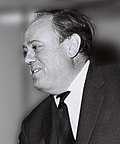 | Christopher Soames
Baron Soames [5] | 5 May
1979 | 14 September
1981 | – Lord President of the Council | Conservative | | Margaret Thatcher |
| | Janet Young
Baroness Young [5] | 14 September
1981 | 11 June
1983 | – Chancellor of the Duchy of Lancaster until April 1982
– Lord Keeper of the Privy Seal from April 1982 | Conservative |
| | William Whitelaw
1st Viscount Whitelaw [5] | 11 June
1983 | 10 January
1988 | – Lord President of the Council | Conservative |
| | John Ganzoni
2nd Baron Belstead [5] | 10 January
1988 | 28 November
1990 | – Lord Keeper of the Privy Seal | Conservative |
| | David Waddington
Baron Waddington [5] | 28 November
1990 | 11 April
1992 | – Lord Keeper of the Privy Seal | Conservative | | John Major |
|  | John Wakeham
Baron Wakeham [5] | 11 April
1992 | 20 July
1994 | – Lord Keeper of the Privy Seal | Conservative |
|  | Robert Gascoyne-Cecil
Viscount Cranborne [5] | 20 July
1994 | 2 May
1997 | – Lord Keeper of the Privy Seal | Conservative |
| | Ivor Richard
Baron Richard [5] | 2 May
1997 | 27 July
1998 | – Lord Keeper of the Privy Seal | Labour | | Tony Blair |
|  | Margaret Jay
Baroness Jay of Paddington [5] | 27 July
1998 | 8 June
2001 | – Lord Keeper of the Privy Seal – Minister for Women | Labour |
| | Gareth Williams
Baron Williams of Mostyn [5] | 8 June
2001 | 20 September
2003 | – Lord Keeper of the Privy Seal until June 2003
– Lord President of the Council from June 2003 | Labour | |
|  | Valerie Amos
Baroness Amos [5] | 6 October
2003 | 27 June
2007 | – Lord President of the Council | Labour |
| 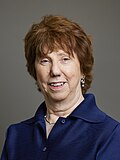 | Catherine Ashton
Baroness Ashton of Upholland [5] | 28 June
2007 | 2 October
2008 | – Lord President of the Council | Labour | | Gordon Brown |
|  | Janet Royall
Baroness Royall of Blaisdon [5] | 2 October
2008 | 11 May
2010 | – Lord President of the Council until June 2009
– Chancellor of the Duchy of Lancaster from June 2009 | Labour |
|  | Thomas Galbraith
2nd Baron Strathclyde [5] | 12 May
2010 | 7 January
2013 | – Chancellor of the Duchy of Lancaster | Conservative | | David Cameron |
|  | Jonathan Hill
Baron Hill of Oareford [5] | 7 January
2013 | 15 July
2014 | – Chancellor of the Duchy of Lancaster | Conservative |
|  | Tina Stowell
Baroness Stowell of Beeston [5] | 15 July
2014 | 14 July
2016 | – Lord Keeper of the Privy Seal | Conservative |
|  | Natalie Evans
Baroness Evans of Bowes Park [5] | 14 July
2016 | 6 September
2022 | Conservative | | Theresa May |
| Boris Johnson |
|  | Nicholas True
Baron True [6] | 6 September
2022 | 5 July
2024 | Conservative | | Liz Truss |
| Rishi Sunak |
|  | Angela Smith
Baroness Smith of Basildon | 5 July
2024 | Incumbent | Labour | | Keir Starmer |


















































































